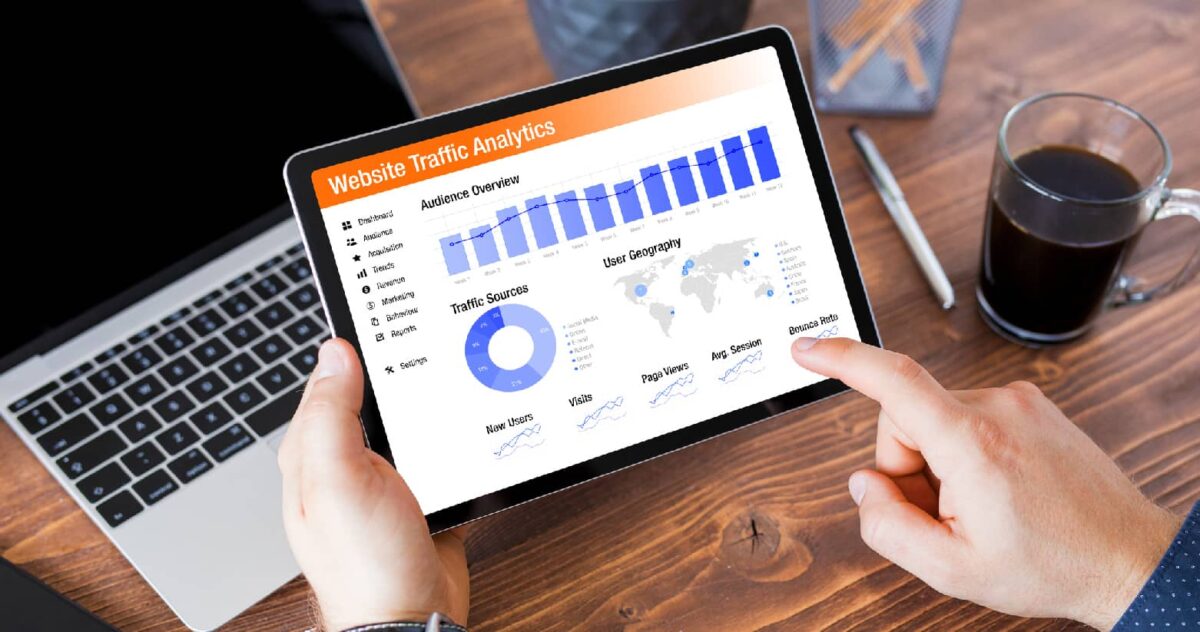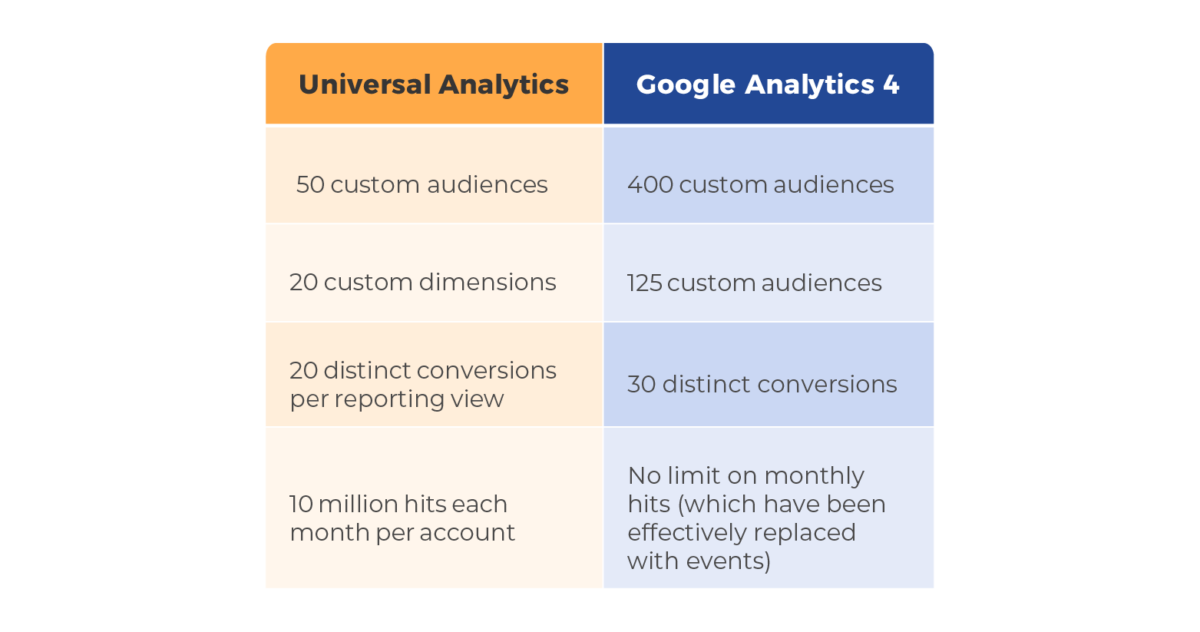If your website is one of the nearly 38 million using Google Analytics, you’ll probably have some feelings about the end of Universal Analytics. This tool has been a staple for countless analysts, strategists, SEO experts, web developers, user experience (UX) designers and other marketing professionals since 2005.
With such a long lifespan for a digital tool, its end inevitably will bring strong emotions—be they jubilant, furious or just nostalgic. To keep the negatives to a minimum, we’ve gathered some insights on how to transition smoothly into the era of Google Analytics 4 (GA4).

The Journey From Universal Analytics to GA4
Google built Universal Analytics with desktop experiences in mind.
The tool launched late in 2005, nearly two years before the first iPhone hit the scene and the smartphone revolution began unfolding. Since nearly all web traffic came from people sitting at a desk or with a laptop, web tools like Universal Analytics catered to the UX preferences, customer journeys, digital literacies and holistic expectations of people who didn’t really know what the smartphone and other mobile devices would bring them.
The way we use the internet is, of course, very different now. Google’s launch of GA4 in 2020 and its decision to sunset Universal Analytics this year are both moves to stay useful and relevant to digital experiences users are having today.

What’s the Same in Both GA4 and Universal Analytics?
Having a strong background in Universal Analytics will definitely help users come to terms with GA4. The list of changes from Universal Analytics is long, however, and not much feels identical.
While Google has shared some detail to highlight much of what will be different moving forward, there are only a handful of instances where Universal Analytics and GA4 directly overlap:
- The user interface of GA4 is much leaner and beginner-friendly—showing fewer options and less data right out of the gate—but will be familiar in terms of overall organization.
- The Admin panel is nearly identical in its interface, though some items included have changed.
- Numerous individual features, such as product linking or site search work the same as they have before.
- Basic reports like the Acquisition Overview or Landing Page report will be very similar to past versions, though GA4’s capability for custom reports does away with many reports that were previously usable.
- Like Universal Analytics, GA4 is free to use.
The good news is that GA4 can do almost everything Universal Analytics did before it. There’s just more of a challenge to build the reports, implement the goals and organize custom dimensions needed to take the place of everything users previously accomplished with Universal Analytics.
In the end, GA4 is here to address the same overall need that Universal Analytics shouldered before it: Giving marketing teams the data they need to understand their audiences, improve UX, optimize content and maximize their web assets all around.

What’s Different Between Universal Analytics and GA4?
GA4 is bigger, more flexible and more compliance-friendly than Universal Analytics. Despite any learning curves it might bring, it’s a more powerful tool in nearly every way.
GA4 Is Bigger Than Universal Analytics
GA4 moves beyond nearly every data cap Universal Analytics featured. It allows more custom audiences, dimensions, and conversions, in addition to a limitless number of events—versus a monthly hit limit built into Universal Analytics. Here’s the breakdown:

GA4 Is More Flexible Than Universal Analytics
A new breadth of customization is just one aspect of GA4’s new advantages. GA4 also utilizes what are called data streams instead of views, feeding multiple data sources into the same property. You can still manage permissions at the account and property level, but by adding up to 50 data streams per property, GA4 lets end users more quickly integrate relevant sources of user data into the same central hub.
For example, brands can now synthesize data from a mobile app and their website by setting each up with a unique data stream—both of which then feed into the same property in GA4. This fusion of data sources eliminates double counting and enables a much clearer cross-platform picture of user journeys. In short, where Universal Analytics was built for desktop experiences, GA4 “is designed to unify both app and web analytics.”
Events Have Replaced Hits, Handing Users the Reins and the Responsibility
By moving from a system of measuring hits to a new process for cataloging events, GA4 lets end users more easily track the steps that matter to them individually. Event customization can replace the need for additional tools focused on tracking downloads, scrolling activity, or other measures that were not directly detectable in Universal Analytics.
GA4 breaks its new events structure into four main categories:
- Automatic events: Users only need to install the GA4 code to begin tracking the 40+ interactions GA4 calls automatic events. These range from scrolling activity to clicks to first visits to a page.
- Enhanced measurement events: Users can choose whether or not to use enhanced measurement events, which primarily measure content engagement within a property. Like automatic events, these are usable right out of the gate. Users are responsible, however, to make sure they don’t capture any personally identifiable information via enhanced measurement events.
- Recommended events: Unlike automatic and enhanced measurement events, recommended events don’t come as default tracking settings. Google sees them as more contextual, breaking them down for functions like online sales, games and general online behavior.
- Custom events: Custom events are exactly what they sound like they would be. Users can demarcate them for each individual property to create a more personalized and relevant tracking process. Users could even recreate existing events using their own methods, though Google advises against this.
New Machine Learning–Based Predictive Metrics Give GA4 Users a Glimpse Into the Future

In addition to GA4’s new events system, the tool has introduced three new predictive metrics rooted in machine learning (ML). These metrics require enough volume to properly train the predictive model, but when that volume is reached, users can tap into a data-informed prognosis on the following:
- Purchase probability (within seven days)
- Churn probability (within seven days)
- Predicted revenue (within 28 days)
As with all predictive metrics, a test-and-learn element is at work here. Google will stop sharing its predictions if a property doesn’t validate the model’s predictions consistently enough. Furthermore, properties need to sustain the volume of data required—continually gathering enough data to inform the model.
Despite these caveats, the new predictive metrics offer a much more direct way to forecast audience actions and revenue than the goals system alone did in Universal Analytics.
Changes in Tracking Methods Have Changed Data Outputs
Net new measures, like GA4’s ML-based predictive metrics, aren’t the only changes. Users will need to familiarize themselves with some updates in how Google is collecting tracking data in the first place.
The regulatory landscape has changed drastically since Universal Analytics first launched. To keep up with the waves of legislation, GA4 has done away with all tracking based on IP addresses. GA4 also offers cookie-less tracking—though end users can still enable the use of first-party cookies. To replace IP addresses and third-party cookies, Google is now using its own signals, such as data from web users who are signed into Google accounts, as well as predictive measurements based on engagement data.
All these changes necessitate some adjustments in how marketers give weight to each metric. Just as significantly, changes should prompt marketers to confirm that their privacy and data use policies are up to date as well.
GA4 Brings a Host of Other Changes
The list of smaller updates could go on as long as this one already has, so here’s a mile-high summary:
- Google has enhanced its analytics integration with other assets like Google Ads, Google Merchant Center and Big Query
- GA4 allows truly customizable dashboards in app, which was not doable in Universal Analytics
- GA4 introduces better search functionality with the new GA4 Search Bar
- Google has unrolled other new metrics, such as engagement rate (which effectually replaces bounce rate, just as other new metrics replace older ones)
In summary, GA4 and Universal Analytics are not the same thing. Marketers should approach this almost as if it were a brand-new tool in their martech stack—not an update of an older one.

How Do We Make the Switch From Universal Analytics to GA4? Where Should We Start?
Universal Analytics properties will no longer log new data after July 1, 2023. So, if you haven’t already created a new GA4 property and data stream (you can’t continue to use a Universal Analytics property), it’s time to do so. Then install the GA4 Global Site Tag on your website and begin testing to ensure it’s working.
Next steps should include all of the following:
- Export your historical data. Google has guaranteed a six-month window during which historical data will be accessible, but there’s no promise after that, so save it now.
- Migrate your data as well. Although not all data will transfer point for point, GA4 does have a process for migrating data from Universal Analytics.
- Test tracking related to your goals and conversions. New features and metrics likely mean that your goals and measurement practices need to change. The launch of new measurement options can inform your tracking strategy and approach to customer journeys in new ways as well.
- Update your reporting strategy. Hand in hand with new tools to collect the data, users now have novel ways to visualize and aggregate it. As such, reporting strategies should evolve too.
- Continue to learn. As was the case with Universal Analytics, there’s already a vast community of analysts and other experts knee deep in the data. This community found hundreds of clever ways to use Universal Analytics, so you can be confident they’ll find similar insights for GA4.
- Start experimenting for yourself. Google’s documentation only tells us so much about what all GA4 can accomplish. With some guided exploration, marketers are likely to find a lot more utility moving forward.
- Expect more changes to come. Perhaps it goes without saying, but today’s digital experiences aren’t here to stay. Marketers should expect to learn a new tool soon enough. The best way to prepare for change, however, is to gather and analyze some data—which is the whole purpose of GA4 in the first place.



